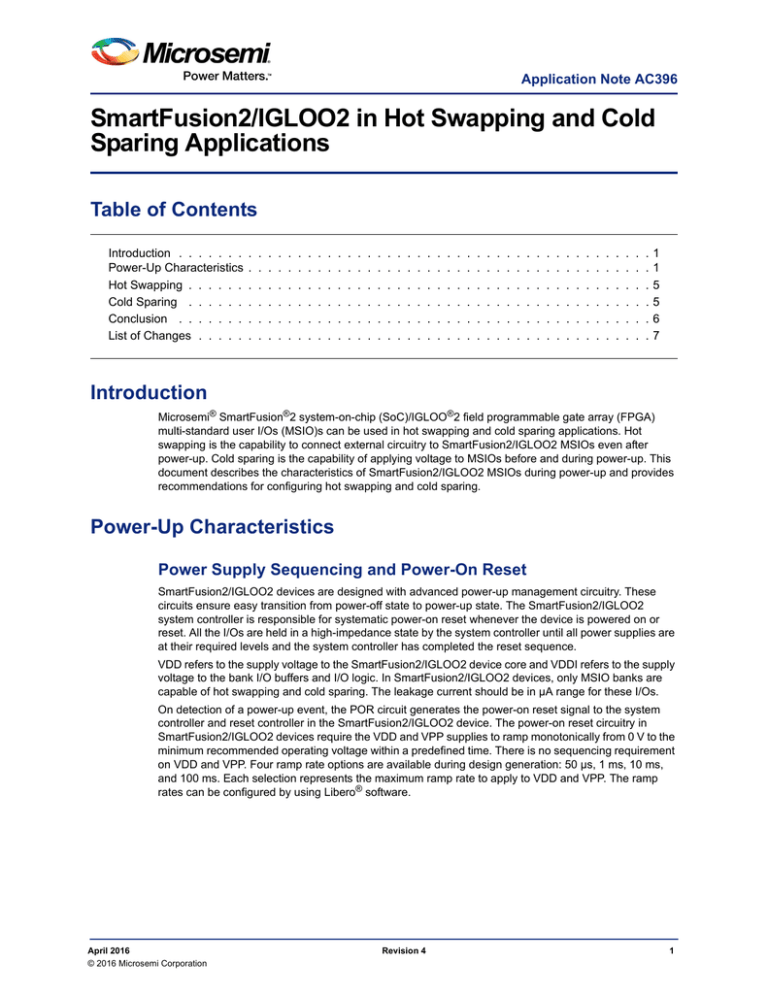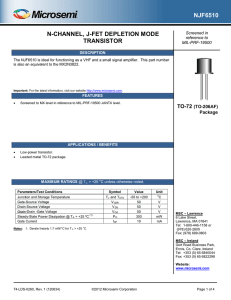
Application Note AC396
SmartFusion2/IGLOO2 in Hot Swapping and Cold
Sparing Applications
Table of Contents
Introduction . . . . . . .
Power-Up Characteristics
Hot Swapping . . . . . .
Cold Sparing . . . . . .
Conclusion . . . . . . .
List of Changes . . . . .
.
.
.
.
.
.
.
.
.
.
.
.
.
.
.
.
.
.
.
.
.
.
.
.
.
.
.
.
.
.
.
.
.
.
.
.
.
.
.
.
.
.
.
.
.
.
.
.
.
.
.
.
.
.
.
.
.
.
.
.
.
.
.
.
.
.
.
.
.
.
.
.
.
.
.
.
.
.
.
.
.
.
.
.
.
.
.
.
.
.
.
.
.
.
.
.
.
.
.
.
.
.
.
.
.
.
.
.
.
.
.
.
.
.
.
.
.
.
.
.
.
.
.
.
.
.
.
.
.
.
.
.
.
.
.
.
.
.
.
.
.
.
.
.
.
.
.
.
.
.
.
.
.
.
.
.
.
.
.
.
.
.
.
.
.
.
.
.
.
.
.
.
.
.
.
.
.
.
.
.
.
.
.
.
.
.
.
.
.
.
.
.
.
.
.
.
.
.
.
.
.
.
.
.
.
.
.
.
.
.
.
.
.
.
.
.
.
.
.
.
.
.
.
.
.
.
.
.
.
.
.
.
.
.
.
.
.
.
.
.
.
.
.
.
.
.
1
1
5
5
6
7
Introduction
Microsemi® SmartFusion®2 system-on-chip (SoC)/IGLOO®2 field programmable gate array (FPGA)
multi-standard user I/Os (MSIO)s can be used in hot swapping and cold sparing applications. Hot
swapping is the capability to connect external circuitry to SmartFusion2/IGLOO2 MSIOs even after
power-up. Cold sparing is the capability of applying voltage to MSIOs before and during power-up. This
document describes the characteristics of SmartFusion2/IGLOO2 MSIOs during power-up and provides
recommendations for configuring hot swapping and cold sparing.
Power-Up Characteristics
Power Supply Sequencing and Power-On Reset
SmartFusion2/IGLOO2 devices are designed with advanced power-up management circuitry. These
circuits ensure easy transition from power-off state to power-up state. The SmartFusion2/IGLOO2
system controller is responsible for systematic power-on reset whenever the device is powered on or
reset. All the I/Os are held in a high-impedance state by the system controller until all power supplies are
at their required levels and the system controller has completed the reset sequence.
VDD refers to the supply voltage to the SmartFusion2/IGLOO2 device core and VDDI refers to the supply
voltage to the bank I/O buffers and I/O logic. In SmartFusion2/IGLOO2 devices, only MSIO banks are
capable of hot swapping and cold sparing. The leakage current should be in µA range for these I/Os.
On detection of a power-up event, the POR circuit generates the power-on reset signal to the system
controller and reset controller in the SmartFusion2/IGLOO2 device. The power-on reset circuitry in
SmartFusion2/IGLOO2 devices require the VDD and VPP supplies to ramp monotonically from 0 V to the
minimum recommended operating voltage within a predefined time. There is no sequencing requirement
on VDD and VPP. Four ramp rate options are available during design generation: 50 µs, 1 ms, 10 ms,
and 100 ms. Each selection represents the maximum ramp rate to apply to VDD and VPP. The ramp
rates can be configured by using Libero® software.
April 2016
© 2016 Microsemi Corporation
Revision 4
1
SmartFusion2/IGLOO2 in Hot Swapping and Cold Sparing Applications
I/O State During Power-Up and Power-Down
Before powering up, all SmartFusion2/IGLOO2 I/Os are in tristate mode. These I/Os remain in tristate
mode during power-up until the voltage supplies (VDD and VDDI) have reached their functional levels.
After VDD and VDDI reach the functional level, the outputs exit the tristate mode and are driven to the
value determined by the user’s design.
The behavior of SmartFusion2/IGLOO2 I/Os is independent of the VDD and VDDI sequence. Figure 1-1
shows a scenario where VDD is powered first, and followed by VDDI. Figure 1-2 shows the scenario
where VDDI is powered first, and followed by VDD.
During power-down, SmartFusion2/IGLOO2 I/Os enter into tri-state mode when either of the power
supplies (VDD or VDDI) drops below its brownout voltage level.
Figure 1-1 • I/O State When VDD is Powered Before VDDI
2
R e vi s i o n 4
Power-Up Characteristics
Figure 1-2 • I/O State When VDDI is Powered Before VDD
Revision 4
3
SmartFusion2/IGLOO2 in Hot Swapping and Cold Sparing Applications
Internal Pull-Up and Pull-Down
SmartFusion2/IGLOO2 I/Os are equipped with internal weak pull-up and pull-down resistors. If used,
these internal pull-up and pull-down resistors are enabled during power-up, when both VDD and VDDI
have reached their functional activation level. Similarly, during power-down, these internal pull-up and
pull-down resistors are disabled when either of the supply voltage (VDD or VDDI) falls below its brownout
detection level.
Table 1-1 lists the devices and the banks that support hot swapping and cold sparing features.
Table 1-1 • SmartFusion2/IGLOO2 Hot Swap and Cold Sparable Banks
Packages
Devices
Hot Swap and Cold Sparing Capability
FC1152
M2S150T/M2GL150T
Banks 0, 3, 4, 5, 6, 8, 11, 14, 17, 18
FG896
M2S050T/M2GL050T
Banks 1, 2, 3, 8
FG676
M2S090T/M2GL090T
Banks 0, 2, 3, 5, 8
M2S060T/M2GL060T
Banks 0, 2, 3, 4, 6, 9
FCS536
M2S150T/M2GL150T
Banks 0, 3, 4, 5, 8, 11, 14, 17, 18
FCV484
M2S150T/M2GL150T
Banks 3, 4, 5, 6, 11, 14, 17
FG484
M2S090T/M2GL090T
Banks 2, 3, 5, 8
VF400
FCS325
VF256
TQ144
M2S050T/M2GL050T
Banks 1, 3, 8
M2S025T/M2GL025T
Banks 1, 2, 4, 7
M2S010T/M2GL010T
Banks 1, 2, 4, 7
M2S005S/M2GL005S
Banks 1, 2, 4, 6
M2S060T/M2GL060T
Banks 2, 4, 6, 9
M2S050T/M2GL050T
Banks 1, 3, 8
M2S025T/M2GL025T
Banks 1, 2, 4, 7
M2S010T/M2GL010T
Banks 1, 2, 4, 7
M2S005S/M2GL005S
Banks 1, 2, 4, 6
M2S090T/M2GL090T
Banks 2, 3, 5, 8
M2S050T/M2GL050T
Banks 1, 2, 3, 8
M2S025T/M2GL025T
Banks 1, 2, 4, 6, 7
M2S025T/M2GL025T
Banks 1, 2, 4, 7
M2S010T/M2GL010T
Banks 1, 2, 4, 7
M2S005S/M2GL005S
Banks 1, 2, 4, 6
M2S010/M2GL010
Banks 2, 4, 7
M2S005S/M2GL005S
Banks 2, 4, 6
Internal Clamp Diode
The system controller puts all of the user I/Os in tri-state mode during power-up. All the user I/Os have
internal clamp diodes to protect the device I/Os. All MSIOs are cold sparable as the internal clamp diodes
are always disabled, except if configured in the PCI I/O standard which are not cold sparable.
For more information about how to connect power and functional pins in SmartFusion2 and IGLOO2
devices, refer to AC393- Board Design Guidelines for SmartFusion2 SoC and IGLOO2 FPGAs
Application Note.
4
R e vi s i o n 4
Hot Swapping
Hot Swapping
Hot Swapping refers to the ability to insert or remove a board into or out of a system during system
operation without causing undesirable effects to the host system or the boards themselves.
SmartFusion2 and IGLOO2 devices support hot swapping on the MSIO pins. To operate in hot swap
mode, MSIO pins must be configured as either an Input or a Tri-state using INBUF or TRIBUF (OE=0)
macros in Libero software. In these configurations, the clamp diodes are disabled, and it avoids high
surge current passing through the pads. MSIOs should not be configured as Output or PCI IO standard
to support Hotswap feature.
Note: User I/Os (MSIOD and DDRIO) and SERDES (see SAR 77590) pins do not support the hot
swapping feature.
Table 1-2 • Hot Swap Functionality
IO Standard
Configuration
OE
Clamp Diode
Notes
MSIO
Tri-state
0
Off
Hotswap Enabled
MSIO
Input
–
Off
Hotswap Enabled
MSIO
Output
–
On
Hotswap Disabled
–
–
On
Hotswap Disabled
PCI
Cold Sparing
In cold sparing applications, voltage can be applied to device I/Os before and during power-up. Cold
sparing applications require the following characteristics to be supported by the device:
1. I/Os must be tri-stated before and during power-up.
2. Voltage applied to I/Os must not power-up any part of the device.
3. Device reliability must not be compromised if voltage is applied to I/Os before or during power-up.
As discussed in the "I/O State During Power-Up and Power-Down" section on page 2, the MSIOs of
SmartFusion2/IGLOO2 are in tri-state mode during power-up. Cold sparing applications rely on this
silicon feature. In cold sparing, voltage may be applied to an I/O before and during power-up of a device.
When the device is powered-off, both VDD and VDDI are clamped to the ground. This prevents the
power supplies from experiencing residual voltage when a voltage is applied to the inputs in a cold
sparing condition.
When these conditions are met, any I/O of an unpowered device can be safely driven with very minimal
leakage current. It is a good design practice not to use outputs of an unpowered (or partially powered)
SmartFusion2/IGLOO2 devices to drive other components in the system.
In SmartFusion2/IGLOO2 devices, only MSIO's support cold sparing feature. The reliability of
SmartFusion2/IGLOO2 MSIOs is guaranteed, if the voltage level applied to the device I/Os is less than
3.6 V as specified in the product datasheets. Therefore, SmartFusion2/IGLOO2 MSIOs meet all three
requirements stated earlier in this section and are suitable for cold sparing applications.
Note: User I/Os (MSIOD and DDRIO) and SERDES pins do not support the cold sparing feature.
Revision 4
5
SmartFusion2/IGLOO2 in Hot Swapping and Cold Sparing Applications
IO Standards Supporting Hot-swap and Cold-sparing
Table 1-3 contains list of IO standards that support Hot-swap and Cold-sparing:
Table 1-3 • IO Standards for Hot-swap and Cold-sparing
IO Standard
LVTTL
PCI
LVPECL (Input only)
LVDS33
LVCMOS12
LVCMOS15
LVCMOS18
LVCMOS25
LVCMOS33
SSTL2I
SSTL2II
SSTL18I
SSTL18II
SSTL15I (only for IOs used by
MDDR/FDDR)
Fabric IOs
MSIOD
MSIO
Yes
Yes
Yes
Yes
Yes
Yes
Yes
Yes
Yes
Yes
Yes
DDRIO
Yes
Yes
Yes
Yes
Yes
Yes
Yes
Yes
Yes
Yes
Yes
Yes
Yes
Yes
SSTL15II (only for IOs used by
MDDR/FDDR)
Yes
HSTLI
HSTLII
LVDS
RSDS
Mini LVDS
BUSLVDS
MLVDS
SUBLVDS (Output only)
Yes
Yes
Yes
Yes
Yes
Yes
Yes
Yes
Yes
Yes
Yes
Yes
Yes
Hot-swap/Cold-spare
MSIO
Yes
Yes
Yes
Yes
Yes
Yes
Yes
Yes
Yes
Yes
Yes
Yes
Yes
Yes
Yes
Yes
Conclusion
SmartFusion2/IGLOO2 devices do not require any specific power-up and power-down sequencing and
have extremely low power-up inrush current in any power-up sequence. SmartFusion2/IGLOO2 devices
supports both cold sparing and hot swapping capabilities.
6
R e vi s i o n 4
List of Changes
List of Changes
The following table shows important changes made in this document for each revision.
Date
Changes
Page
Revision 4
(April 2016)
Updated "IO Standards Supporting Hot-swap and Cold-sparing" section (SAR 78476)
6
Revision 3
(August 2015)
Updated "Hot Swapping" section (SAR 66982)
5
Revision 2
(June 2015)
Updated "I/O State During Power-Up and Power-Down" section (SAR 64130).
2
Updated Table 1-1 and Added Table 1-2.
Revision 1
(June 2014)
Revision 0
(May 2013)
4 and 5
Removed "Driving an Unpowered Device" section.
4
Updated "Hot Swapping" section (SAR 66982).
5
Updated "Cold Sparing" section.
5
Updated the "Hot Swapping" section for MSIOs and SERDES pins support
(SAR53021).
5
Updated Table 1 for IGLOO2 devices of hot swap and cold spar (SAR53021).
3
Updated the document for IGLOO2 support (SAR53021).
NA
First Release.
NA
Note: *The revision number is located in the part number after the hyphen. The part number is displayed at the bottom
of the last page of the document. The digits following the slash indicate the month and year of publication.
Revision 4
7
Microsemi Corporation (Nasdaq: MSCC) offers a comprehensive portfolio of semiconductor
and system solutions for communications, defense & security, aerospace and industrial
markets. Products include high-performance and radiation-hardened analog mixed-signal
integrated circuits, FPGAs, SoCs and ASICs; power management products; timing and
synchronization devices and precise time solutions, setting the world’s standard for time; voice
processing devices; RF solutions; discrete components; enterprise storage and communication
solutions, security technologies and scalable anti-tamper products; Ethernet solutions; Powerover-Ethernet ICs and midspans; as well as custom design capabilities and services.
Microsemi is headquartered in Aliso Viejo, Calif., and has approximately 4,800 employees
globally. Learn more at www.microsemi.com.
Microsemi Corporate Headquarters
One Enterprise, Aliso Viejo,
CA 92656 USA
Within the USA: +1 (800) 713-4113
Outside the USA: +1 (949) 380-6100
Sales: +1 (949) 380-6136
Fax: +1 (949) 215-4996
E-mail: sales.support@microsemi.com
© 2016 Microsemi Corporation. All
rights reserved. Microsemi and the
Microsemi logo are trademarks of
Microsemi Corporation. All other
trademarks and service marks are the
property of their respective owners.
Microsemi makes no warranty, representation, or guarantee regarding the information contained herein or
the suitability of its products and services for any particular purpose, nor does Microsemi assume any
liability whatsoever arising out of the application or use of any product or circuit. The products sold
hereunder and any other products sold by Microsemi have been subject to limited testing and should not
be used in conjunction with mission-critical equipment or applications. Any performance specifications are
believed to be reliable but are not verified, and Buyer must conduct and complete all performance and
other testing of the products, alone and together with, or installed in, any end-products. Buyer shall not rely
on any data and performance specifications or parameters provided by Microsemi. It is the Buyer's
responsibility to independently determine suitability of any products and to test and verify the same. The
information provided by Microsemi hereunder is provided "as is, where is" and with all faults, and the entire
risk associated with such information is entirely with the Buyer. Microsemi does not grant, explicitly or
implicitly, to any party any patent rights, licenses, or any other IP rights, whether with regard to such
information itself or anything described by such information. Information provided in this document is
proprietary to Microsemi, and Microsemi reserves the right to make any changes to the information in this
document or to any products and services at any time without notice.
51900264-4/04.16



